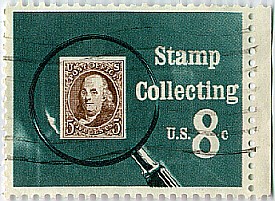Getting Started with Stamp Collecting - page 3
Although not strictly necessary, you can buy tweezers for easy handling of your stamps. These are not expensive
and will help keep grubby chocolate fingerprints off your stamps.
Also not necessary, but a real help, is a stamp "catalogue". This is a wonderful aid for telling you the
description of stamps. You will see that stamps are often issued in "sets",
issued by the Post Office all at the same time. Clue: maybe organizing your stamps by "sets" is a way to go?
You can find out-of-date catalogues at bargain prices, but if you want the latest stamps, you must buy a
new catalogue. You can buy them for a single country, or you can buy one that includes many countries.
You might also find stamp catalogues at your public library.
What else do you need? Well, actually - nothing!! Put some stamps into an album and you are now a stamp
collector. Congratulations!! In fact, you can also call yourself a "philatelist", because stamp collecting
is known as "philately", in fancy language.
 As you become more involved with the hobby, you might want some additional equipment. A magnifying glass
is useful if you become interested in small details of stamps, such as printing mistakes that may be hard to see
without a magnifier. Just don't leave the magnifying glass on the table in the bright sunlight -
things can get burned that way!
As you become more involved with the hobby, you might want some additional equipment. A magnifying glass
is useful if you become interested in small details of stamps, such as printing mistakes that may be hard to see
without a magnifier. Just don't leave the magnifying glass on the table in the bright sunlight -
things can get burned that way!
Another useful accessory is a perforation gauge. You know those jagged edges
around modern stamps? They are called perforations, because the sheets of stamps are 'perforated' with holes
to make it easier to tear off a stamp from the sheet.
At one time, they didn't do that, so you had to cut the stamps off the sheets, using scissors. Those old stamps
without perforations are called "imperforate". Anyway, I do ramble, don't I? The perforation gauge I mentioned
can be used to measure the number of perforations on any stamp. So why would anyone in their right mind want
to do that? Well, there was a time when certain stamps were issued that had perforations closer to each other than
did other issues of the same stamp! And, collectors being collectors, they found that it was useful to know
which was which.
For example, suppose you have 20 copies of the same stamp that was issued with different perforations (you can
find out that by looking in your handy catalogue). Using the perforation gauge to measure the perforations on
each stamp, you might find that some of them measure 11.5, and some measure
12. Your catalogue should tell you that this stamp was issued in both perforation sizes. Often, we stamp collectors
(you and me) shorten the word to "perf". So, say that you have 2 stamps with perf 12, and 18 stamps with
perf 11.5. Your catalog might tell you that the perf 12 stamps are worth 3 times as much as the others, so it was good
to have that accessory!
Some older stamps were printed on paper that had invisible marks in it. These marks are called "watermarks"
and can be seen with special equipment. One way is to use a special liquid in a black tray.
DO NOT try this without help from an adult!! Ask your stamp store for advice.
A final word about equipment. You do not have to have any of the fancy things to enjoy your hobby! The
important thing is to have fun learning, then later on see if you want to get more serious about it.
Learn more about what the words mean - click DEFINITIONS
 As you become more involved with the hobby, you might want some additional equipment. A magnifying glass
is useful if you become interested in small details of stamps, such as printing mistakes that may be hard to see
without a magnifier. Just don't leave the magnifying glass on the table in the bright sunlight -
things can get burned that way!
As you become more involved with the hobby, you might want some additional equipment. A magnifying glass
is useful if you become interested in small details of stamps, such as printing mistakes that may be hard to see
without a magnifier. Just don't leave the magnifying glass on the table in the bright sunlight -
things can get burned that way!